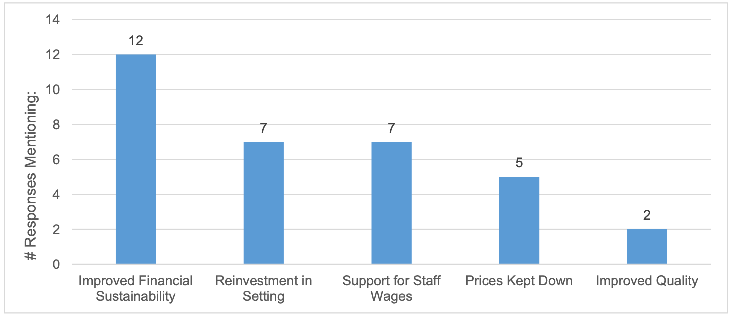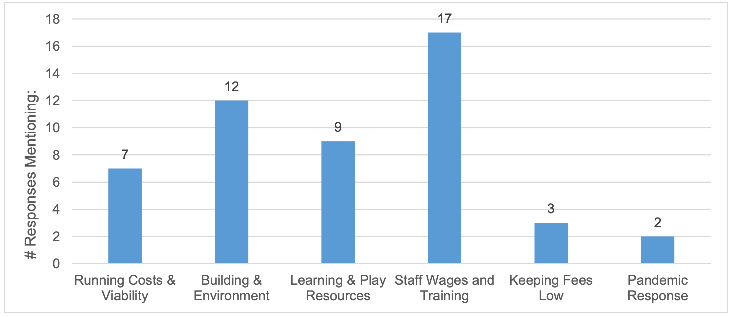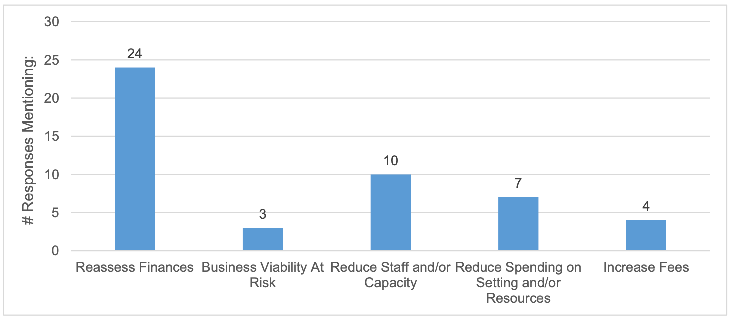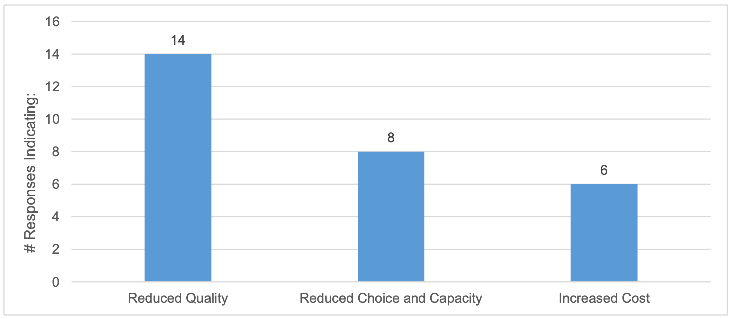Nursery rates relief: evaluation
Evaluation of the nursery non-domestic rates relief scheme implemented in Scotland during 2018. We committed to evaluating the benefits of the scheme after it had operated for three years.
5. Views of private and third sector providers
The views of private and third sector providers were sought on what impact (if any) the relief has had on their business, as well as the children who attend, and their parents and carers; and what the impact of the scheme being removed would be. While the difficulty in directly linking NDR relief savings to individual spending decisions within a childcare provider is acknowledged, the relatively high and quantifiable value of the relief to each eligible setting should provide weight to the opinions of childcare providers on its value, and the impact of removing it.
A short questionnaire was distributed via some of the childcare representative bodies[19] seeking direct qualitative feedback. There has been a large number of exercises collecting information from the sector ahead of the survey being issued and some survey fatigue was anticipated. A total of 26 providers in the private and third sector responded to the survey. Their responses are summarised below. Where an open question is asked, respondents could provide more than one response.
Caution must be applied to interpreting the results due to both the small sample size (only around 1.5% of all providers in the private and voluntary sectors), and given that NRR will have provided at least an immediate financial benefit to respondents upon its introduction.
Scottish Government officials also conducted interviews with two childcare providers to obtain further direct feedback. Many of the themes highlighted in the survey responses, as set out below, were also mentioned by the interviewees[20].
5.1 Do you think the Nursery Rates Relief Scheme has had an impact on your setting?
Most respondents (24 out of 26), perhaps unsurprisingly, described the NDR relief as having an impact on their setting. The survey then asked those 24 respondents responding positively to describe the impact. The most common responses are highlighted at Figure 10.
The most commonly cited impact, quoted by half of all respondents, was an easing of financial pressures, and increased sustainability of the business. Of those 12 mentioning cost pressures, three respondents noted that their business may not have remained viable without the relief.

Those providers who answered that the relief had not had an impact noted they were not eligible for NRR.
5.2 How has money saved via Nursery Rates Relief been spent within your setting?
Providers were asked to identify where money saved via NRR had been spent in their setting, and asked for specific examples. Respondents could provide multiple answers, and the most frequently identified areas of spending given in response are highlighted at Figure 11.

The most commonly cited answer was that money saved via the relief had been prioritised to spending on the workforce, with nearly two thirds of respondents stating that the recruitment and retention of staff, paying increased wages, and providing staff training had been their priority. Nearly half of respondents had been able to use the savings to improve the learning environment, including indoor and outdoor facility improvements, while just over a third had been able to spend on learning and play resources. Around a quarter of surveyed settings stated that savings on nursery rates had to be diverted to meet running costs and/or help ensure the business remained viable.
5.3 What impact(s), if any, has this spending had on your setting, the attending children, and/or their parents and carers?
The survey then asked providers to estimate the impact of this spending on parents, carers and the attending children. While this produced a wide variety of specific responses, two central themes are evidenced.
First, of the 22 providers who responded to this question, 15 suggested spending that would have increased the quality of the childcare being delivered. This was based upon spending on the environment and building, learning resources, and staff; along with providers who had directly indicated an improvement in the quality of their childcare provision. The improvement to quality will be of direct benefit to the children attending, with one provider also mentioning that the spending enabled improvements to parental communications.
Secondly, 8 of the 22 providers indicated that parents and carers have benefitted from the provider being able to maintain lower fee costs than they would have been able to deliver had the rate relief not been available. This would indicate that a removal of the rate relief may produce an upward pressure on fees charged for childcare delivered outside of the funded ELC hours.
5.4 Would the removal of the Nursery Rates Relief Scheme have an impact on your setting?
The survey then asked providers about the potential impacts of removing the rate relief. A large majority, 24 of 26 participants responding, reported that there would be an impact. One provider who indicated that it would not have an impact was not currently eligible for the relief, with the remaining participant unsure.
Providers were then asked the expected impact of the removal (Figure 12). Almost all affirmative responses (24 of 25) indicated a degree of financial re-evaluation within the business to accommodate the resulting increase in costs. 10 indicated that they would struggle to maintain current staffing levels and pay and/or child capacity if rates were reintroduced, suggesting a significant re-shaping of their business could be required. Three of these providers were unsure if their business would remain viable. Over a quarter of responses indicated a reduction in other spending that may reduce overall quality in the service (such as spending on resources and trips), while four providers noted that they would need to increase fees for non-ELC hours.

5.5 Would the removal of the Nursery Rates Relief Scheme have an impact on the children who attend your setting and/or their families?
The large majority of providers responding (23 of 26) indicated that there would be an impact to children and their families were the rates relief scheme to end.
Those responding positively were then asked to indicate what impact might be expected. Three themes emerged in the 22 responses to this question, which are shown at Figure 13.

The most common concerns were those that would result in a reduction in the quality of provision. This includes providers who were concerned at staff training and turnover, with an even stronger downward pressure on the wage bill leading to higher staff turnover and less experienced and settled staff, as well as reduced spending on other resources and activities, and future improvements.
Over a third of respondents felt that there would be impacts from the overall decreased financial viability of the sector, with these responses suggesting that settings could downsize and/or close, which would result in reduced capacity and choice for children and their families.
Over a quarter of respondents mentioned that it would be necessary to increase prices for non-ELC hours in order to accommodate the relief ending, with this expected to particularly impact on prices charged for the 0-2 age group.
Contact
Email: ELCPartnershipForum@gov.scot
There is a problem
Thanks for your feedback